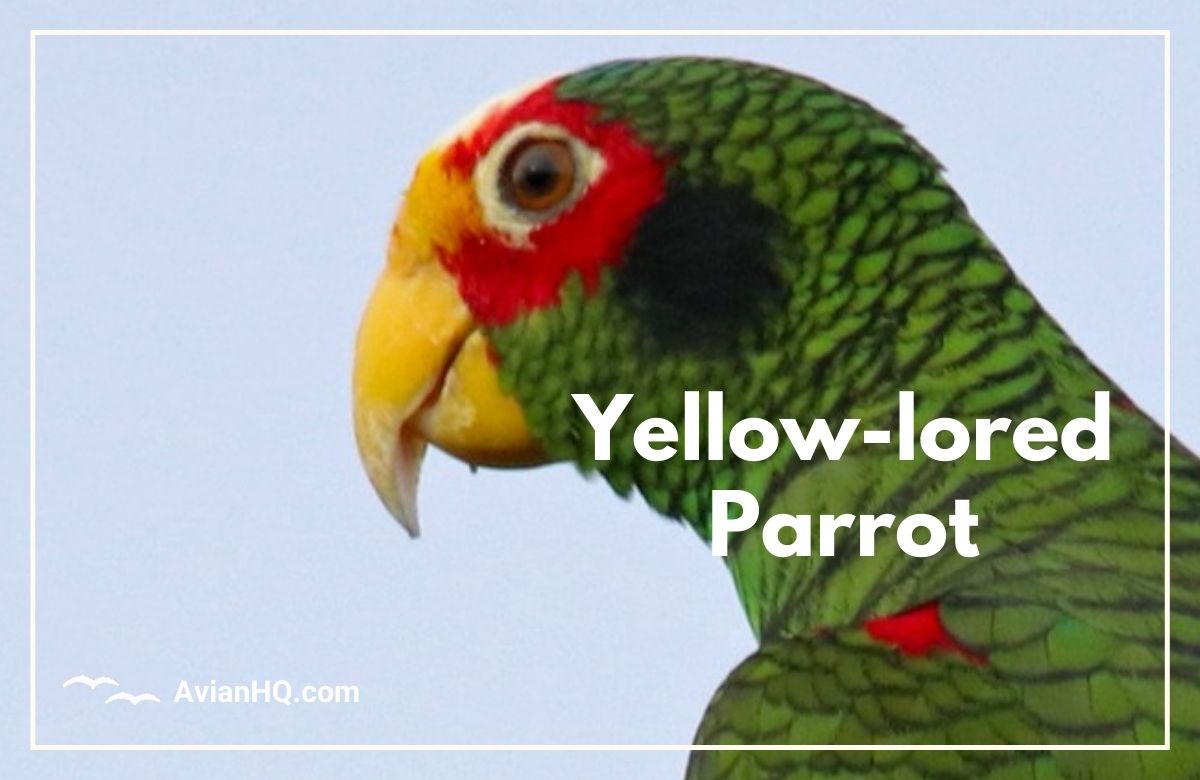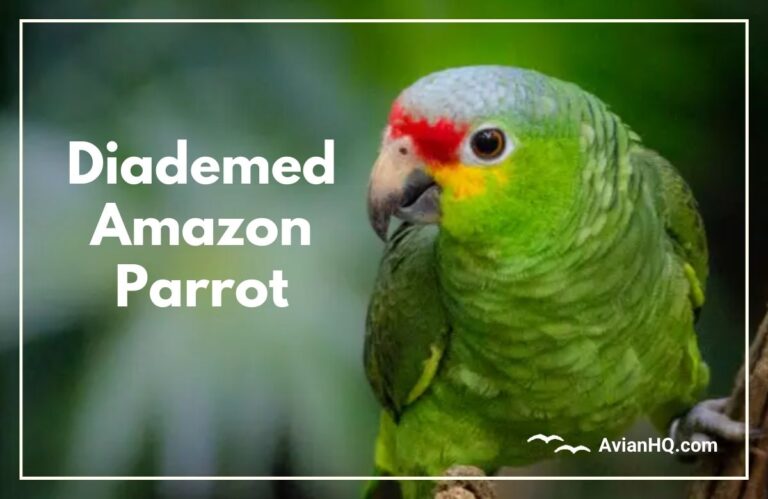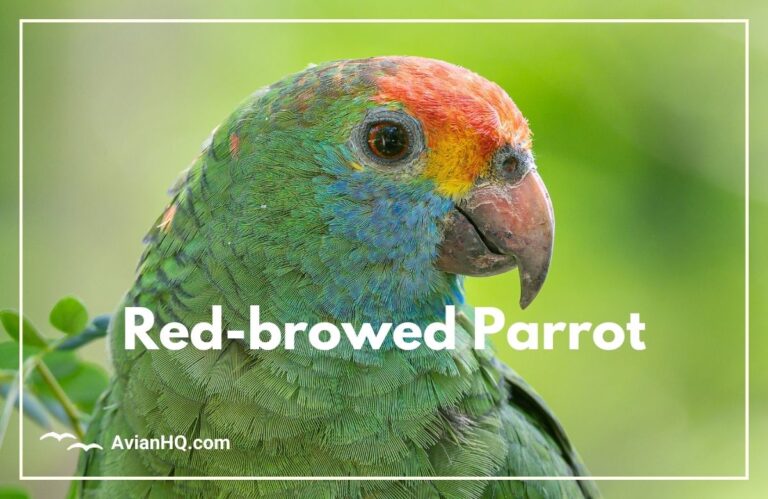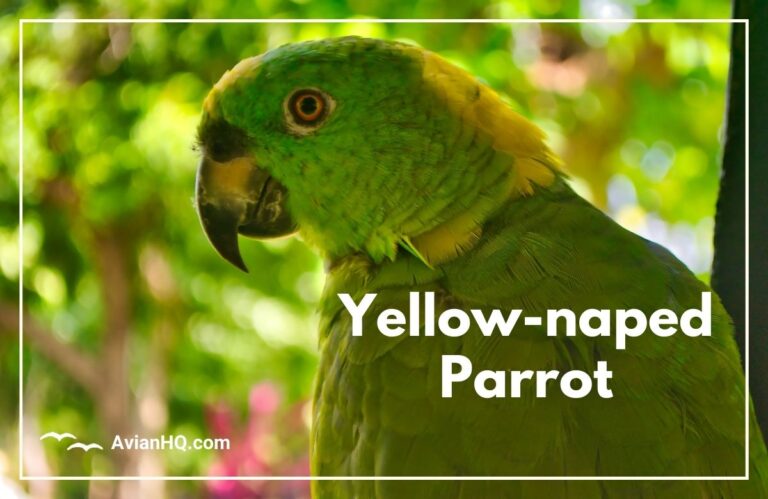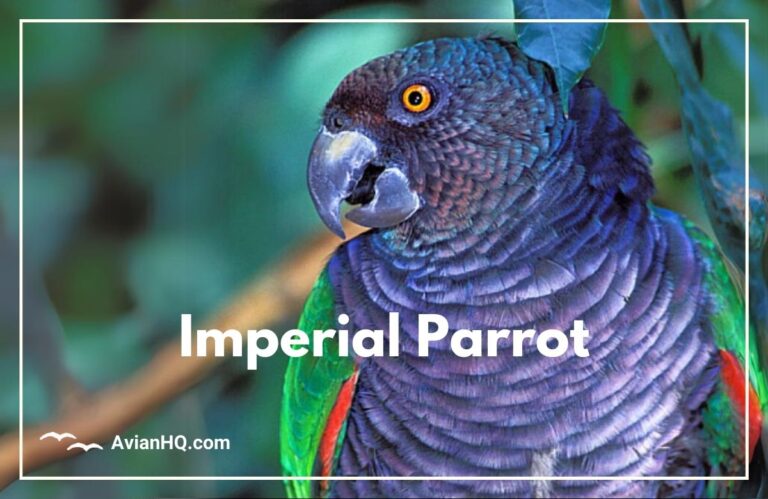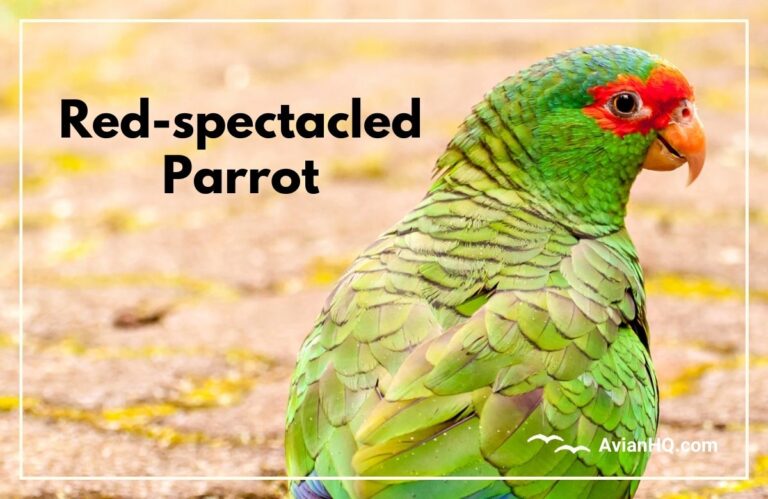Yellow-lored Parrot (Amazona xantholora)
The vibrant yellow “masks” around their eyes are the most distinguishing feature of these vibrant green parrots found in Mexico’s Yucatán Peninsula and nearby regions. As you read on, you’ll uncover more about the biology and behaviors of the Yellow-lored Parrot (Amazona xantholora), a species that has captured the attention of nature enthusiasts, aviculturalists, and conservationists alike.
You may also hear these parrots referred to as Yucatán Amazons or Yellow-lored Amazons. Growing approximately 25-28 cm (10-11 inches) long and weighing around 200-232 grams (7-8 ounces), they are medium-sized parrots of the genus Amazona.
While not currently considered threatened, these parrots have a restricted habitat range and face ongoing pressures from deforestation and illegal wildlife trade. Their bright colors and intelligence also make them desirable as pets.
As we explore the Yellow-lored Parrot’s defining features, you’ll uncover what makes them unique and why protecting their tropical ecosystem homes is vital. From their dietary preferences to the intricate dances of their courtship rituals, be prepared to have your heart stolen by these charismatic birds!
The sections ahead will lead you through the Yellow-lored Parrot’s:
- Taxonomy and history of discovery
- Distinctive physical attributes
- Geographic distribution and territorial ranges
- Foraging habits and nutritional requirements
- Complex social behaviors and family bonds
- Reproductive processes and parenting
- Current conservation status and protective actions
Gaining a well-rounded perspective on this species will help ignite your passion for preserving parrots around the globe. So let your fascination take flight as we delve into the dynamism of the Yellow-lored Parrot!
Scientific Classification and Discovery
The Yellow-lored Amazon Parrot is member of the diverse order Psittaciformes, which contains all parrot species. More specifically, it is part of the family Psittacidae and the subfamily Arinae, which are New World parrots native to the Western Hemisphere.
First Formal Description
The first official scientific description of the Yellow-lored Parrot dates back to 1859, when British ornithologist Philip Lutley Sclater documented the species under the scientific name Chrysotis xantholora. Over time, the species was reclassified into the genus Amazona, reflecting a better understanding of parrot evolutionary relationships.
Taxonomy
Here is how the Yellow-lored Parrot fits into the hierarchical taxonomic classification system:
- Kingdom: Animalia
- Phylum: Chordata
- Class: Aves
- Order: Psittaciformes
- Family: Psittacidae
- Subfamily: Arinae
- Genus: Amazona
- Species: Amazona xantholora
The Amazona genus contains 30+ species of mainly Central and South American parrots. Fortunately, no subspecies of the Yellow-lored Parrot have been identified.
Behind Its Scientific Name
The genus name Amazona loosely translates to “breast without corn” in reference to most species lacking any yellow or orange patch on the chest.
The Yellow-lored Parrot’s specific epithet xantholora derives from the Greek words xanthos meaning “yellow” and loros for “nape, back of the neck.” This neatly describes the yellow patches between their eyes and beak that inspired one of their common names.
Physical Appearance
The vibrant plumage and distinctive facial markings make the Yellow-lored Parrot stand out among its parrot relatives. Understanding their specialized physical features also provides insight into their behaviors and habitat adaptations.
Size and Weight
These stocky parrots reach an average length of 25-28 centimeters (10-11 inches), which includes the tail. Their wingspan stretches approximately 38 centimeters (15 inches) wide.
Adults typically weigh between 200-232 grams (7-8 ounces). As medium-sized parrots, the Yellow-lored Parrot is larger than budgies and cockatiels but smaller compared to macaws or Amazons.
Colorful Plumage
Their overall bright green plumage has a scaly appearance due to black feather edging throughout the body, wings, and tail. The most vibrant coloring occurs on the head and neck regions.
- Forehead and Crown: White or pale blue. Males have more extensive yellow-white patches than females.
- Mask: Bright golden-yellow patches on the lore area between the beak and eyes.
- Eyes: Circled by bright red bare skin. iris color ranges from orange to brown.
- Ear Coverts: Blackish feathers behind the eyes.
- Neck: Patchy distribution of green and faded blue feathers.
- Beak: Yellowish horn color.
- Legs: Bluish-grey feet with dark gray claws for grasping.
The green and blue coloration becomes more extensive on the back, chest, wings, and tail. Yellowish-green underparts round out their vibrant palette.
Gender Differences
Mature males and females look quite similar except adult males have more prevalent yellow-white feathers on the top and sides of the head. Females also display less red bare skin around the eyes.
Juvenile birds resemble adult females but have darker grey eye coloration until their first molt.
Specialized Features
Their sturdy hooked bill easily cracks hard nuts and seeds. A strong muscular tongue aids in grasping food items. Sharp vision facilitated by the laterally placed eyes allows for scanning the skies and canopy for predators and food sources.
Zygodactyl feet with two toes facing forward and two facing backwards provide agility and stability when climbing vertical forest surfaces and tree cavity nests. Their swift, direct flight reaches speeds up to 35 mph aided by specialized feather structures in the wings and tail.
Geographic Distribution and Habitat
The distribution of the Yellow-lored Parrot is limited to southern Mexico’s Yucatán Peninsula and small adjoining regions in Central America, constraining available habitat and conservation efforts.
Native Range
Populations of Yellow-lored Parrots naturally occur in the Mexican states of Campeche, Quintana Roo, and Yucatán that comprise the Yucatán Peninsula. Their range marginally extends into neighboring areas of northern Belize and Guatemala as well.
The species was also collected from Honduras’ Isla de Roatán in the 1940s but few records exist today. One isolated resident group inhabits Cozumel Island off the Yucatán’s east coast.
Suitable Habitat
These parrots closely associate with tropical forests featuring deciduous and semi-deciduous vegetation. This includes both disturbed secondary forests and patches of primary forest with mature tall trees.
They also occupy scattered pine and pine-oak woodlands. A preference exists for forest edge areas and semi-open canopy conditions. Mangroves provide another key habitat type in coastal areas.
Elevation Range
Sea level up to approximately 300 meters (1000 feet) represents the typical elevation limits. The highest density spotted at lower elevations less than 100 meters (330 feet) since more open, drier forests prevail there. Rare sightings occur above 1000 feet.
Population Trends
While the current global population has not undergone thorough evaluation, estimates suggest 20,000 to 50,000 mature individuals exist presently. Their numbers seem to be steadily declining owed to habitat degradation and poaching pressures. Protecting viable breeding populations represents a conservation priority.
Further scientific surveys are vital for accurately tracking population fluctuations to better inform management plans for these parrots.
Diet and Feeding Behaviors
The Yellow-lored Parrot utilizes an array of food sources to meet its nutritional requirements. Understanding what composes their varied diet provides hints to their habitat preferences and foraging strategies.
Diverse Omnivorous Diet
As opportunistic feeders, their diet changes based on seasonal availability taking advantage of abundant fruits, seeds, nuts, and some edible flowers or buds in their home range.
Documented food items include:
- Fruits – orchids, figs, podocarpus, mulberries, sapodillas
- Seeds and nuts – pine nuts, almonds, chestnuts
- Flowers and nectar – banana, cassia, eucalyptus
- Leaf buds, shoots, and some insects complete their mixed diet
Strong muscular jaws make it possible to crack hard palm nuts. A specialized tongue even aids in manipulating and hulling seed kernels.
Feeding Patterns
The Yellow-lored Parrot often utilizes a technique called “blossom nomadism” whereby groups track the sequential flowering and fruiting cycles across their territory.
They concentrate much foraging activity in tall forest canopy levels. But will readily exploit food bonanzas at lower levels and clearings associated with forest disturbances.
Relying on scattered food sources selects for wide-ranging movements up to 5-10 miles a day. Close associations with food-rich forest edge areas offers efficiency between roosting and feeding zones.
Adaptations for Feeding Success
Several key adaptations aid their feeding efficiency including sensitive sight to spot fruits and seeds, swift flight to canvass large feeding areas, strong bills for cracking hard food items, and zygodactyl feet providing stability and mobility in trees.
Groups also exchange information about food locations and predator threats using an array of vocalizations and visual displays. This social information flow ultimately enhances the feeding success across all group members.
Breeding and Reproduction
The bonding and breeding behaviors of the Yellow-lored Parrot reveal striking complexities underlying their social structures and reproductive strategies.
Nest Sites
Tree cavities represent the nearly exclusive nest sites sought out by breeding pairs, which offer security and insulation. Holes formed by decay in older trees are preferred, ranging 15-45 feet (5-15 meters) above ground.
On occasional, crannies on cliff faces provide alternative nesting opportunities. Entrance holes average 2-3 inches (5-8 cm) wide. Deep interiors typically measure 0.5-3 feet (15-100 cm) across.
Pair Courtship
Monogamous pairs engage in elaborate courtship rituals to reinforce social pair bonds. Synchronized duets, mutual feeding displays called “allopreening,” and joint investigative flights called “rhythm flights” are common.
These bonds appear stable across years. However, if a mate dies, the surviving parrot will accept another partner. Courtship and mating occurs in early spring before nesting duties.
Clutch Details
The breeding female lays a clutch of 3-5 eggs within the chosen nesting cavity. The smooth white eggs measure about 1 1⁄4 inches (30 mm) long and 1 inch (25 mm) wide.
Eggs are laid at 2-3 day intervals. Incubation regulation probably occurs through hormonal levels rather than ambient temperatures.
Incubation Period
Only female incubates while the male provides food through the 26 day incubation period. Eggs typically hatch in the order laid, causing asynchronous chick ages. Parents devote tremendous energy attending the high needs chicks.
Fledgling Timeframe
Both parents share feeding and defensive duties as the chicks grow, especially females. Nestlings initially weigh about half an ounce. Feather quills start emerging within a couple weeks.
The altricial young remain in the nest cavity for 7-8 weeks before fledging. Immature fledglings will continue to beg parents for feedings as they learn independence.
Behavior and Ecology
The Yellow-lored Parrot exhibits complex behaviors and ecological roles that emerge from its group dynamics, territoriality, and forest environment.
Social Flocking
Yellow-lored Parrots live in dynamic flocks of 30-60 members on average. During periods of abundant food, congregations up to 100-500 may temporarily form. Seasonal fluctuations occur.
Established flocks represent family groups with extensive social hierarchies and structured mating patterns. Flocks often nest in loose aggregations. Foraging, preening, and defensive actions all operate at a group level.
Daily activities commence with morning departure to feeding areas. Before dusk, socializing intensifies upon return to traditional roost trees, where preening, vocal exchanges, and acrobatics transpire before nightfall.
Roosting Patterns
Besides the main sleeping cavity guarded by sentinels, alternative temporary roost locations exist across a home range. Some gatherings at dormitory sites may exceed 1,500 individuals!
But the typical overnight roost might contain a few hundred members or less. Sites often get reused annually. Preferences show for tall, mature trees with dense covering and cavity clusters that afford protection.
Foraging Behaviors
During daylight hours, extended flights occur between nesting areas and prime feeding zones up to 5-10 miles distance. Upon arriving at destination trees in units of 5-20, intensive bustling and loud vocalizing ensue as fruits and seeds get consumed.
Direct pursuit of fruits accounts for over 50% of feeding activity. Bark scaling, blossom probing, and aerial hawking of insects occur secondarily. Foraging parties exhibit well-coordinated actions that concentrate harvests but minimize intra-flock competition.
Forest Ecosystem Roles
As prolific seed dispersers and pollination agents for canopy trees, Yellow-lored Parrots provide vital ecological services to rainforest ecosystems. Their disappearances often negatively impact associated vegetation and fauna.
As secondary cavity nesters unable to excavate holes directly, they also rely on a healthy presence of woodpeckers and decay fungi to generate nesting opportunities. Protecting these key habitat resources ensures positive cascading effects.
Conservation Status and Threats
Despite a lack of imminent threats, multiple concerning pressures afflict populations of the Yellow-lored Parrot across its restricted range. Ongoing habitat and species protections remain vital for future sustainability.
IUCN Classification
The IUCN Red List currently categorizes the Yellow-lored Parrot as Least Concern based on range extent and population sizes. However, updated surveys are lacking. Their status merits re-evaluation.
Population Estimates
In the absence of systematic surveys, published opinions estimate the total adult population between 20,000 to 50,000 breeding individuals. However, no robust field data confirms this approximation that shows a declining trajectory generally.
Major Threats
- Deforestation: Logging, land conversion, and infrastructure development continue fragmenting its specialized forest habitats. Reduction in old-growth nesting trees also occurs.
- Wild-caught Trade: Smuggling of trapped parrots for the pet industry persists illegally despite Mexican restrictions. An estimated 6,000 parrots got traded over a decade with one-fourth being Yellow-lored Parrots.
- Climate Change: Hotter, drier climatic conditions could degrade the tropical deciduous woodlands this species inhabits in Central America.
Conservation Actions
- Mexican federal law classifies the Yellow-lored Parrot as threatened, prohibiting hunting/extraction. But improved enforcement is required.
- Trade restrictions enacted under CITES Appendix II agreement aim to control illegal capture and transport.
- Select reserves protect excellent quality habitat. Continued expansion of protected areas should prioritize intact breeding habitat.
- Community engagement and eco-tourism support additional habitat protections while offering alternative livelihoods.
Sustained conservation attention and protected area networks will provide this brilliant parrot the security to continue brightening the forests of Mexico and Central America.
Cultural Significance and Relationship with Humans
The vibrant colors and vocal talents of the Yellow-lored Parrot have captivated the attention of many cultures over time. Their attributes continue enthralling modern observers as well.
Significance in Ancient Cultures
Representations of parrots have been uncovered in the archaeological remnants of ancient Mayan and Aztec societies once inhabited the Yucatán Peninsula and Central America. Mosaics, pottery, and hieroglyphic scripts depicted parrots.
As one of the few native parrots, Yellow-lored Parrots likely held cultural value for divination rituals, symbolic imagery, trade items, or food sources in pre-Columbian times before extensive deforestation.
Appeal as Pet Trade Species
The engaging temperaments and abilities to mimic speech have made Yellow-lored Parrots popular in the cage bird trade. Their natural beauty and graceful behaviors readily capture human fascination and admiration for parrots generally.
Unfortunately, illegal trapping of wild parrots persists across parts of their range. Better enforcement and captive breeding programs are required to meet market demands responsibly without threatening wild populations.
Eco-tourism Potential
Birdwatchers eagerly seek sightings of Yellow-lored Parrots gracing forest canopy levels in sounds of Mexico’s biodiverse Yucatán Peninsula. The accessibility from nearby tourism gateways offers unique eco-tourism potential.
Community-based conservation initiatives would allow visitors to ethically observe these birds up close while also empowering local people as stewards protecting critical habitat. Such programs have achieved success for Guatemala’s Red-lored Parrot.
Ambassadors for Forest Conservation
The intrinsic value and ecological services of the Yellow-lored Parrot and its rainforest ecosystem homes provide reason enough for conservation. But their cultural charisma and eco-tourism appeal give added incentives for preserving Central America’s stunning yet imperiled forests.
Conclusion
The vibrant and vocal Yellow-lored Parrots stand out as charismatic rainforest inhabitants restricted to the vanishing tropical deciduous forests of Mexico’s Yucatán Peninsula and neighboring Central America.
While valued by humans and vital to forest ecosystems, pressures from deforestation, climate change, and illegal pet trading threaten to silence their boisterous flocks. Improved legal protections and expanding nature reserves aim to safeguard their limited endemic range.
Yet truly securing their future requires restoring the intricate forest systems they depend on and inspire us to conserve. The synergies possible through community forest stewardship, eco-tourism, and poverty alleviation offer promise for the Yellow-lored Parrot while benefiting local people too.
Beyond ticking the boxes as Least Concern, the Yellow-lored Parrot reminds us to dig deeper into the wonders of the natural world. Their flashy plumage and raucous calls beckon us to take notice and take action. For they represent the incredible biodiversity at stake.
By rallying around focal species like the charismatic Yellow-lored Parrot as forest ambassadors, we stand a better chance of preserving Central America’s threatened yet life-sustaining tropical woodlands for future generations. Our children deserve the opportunity to be dazzled by these brilliant parrots as they trumpet from sun-streaked jungle canopies. Let their persistent voices resonate in our collective conscience.

